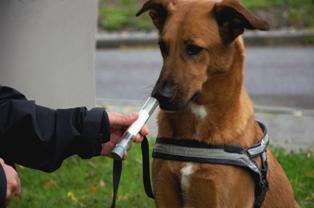Dogs can detect lung cancer from breath
25 August 2011
Sniffer dogs could be used for the early detection of lung cancer from the breath of patients, according to researchers at Schillerhoehe Hospital in Germany.
The research shows that there are specific marker chemicals that indicate lung cancer and that further research is needed to identify them.
Lung cancer is the second most frequent form of cancer in men and women across Europe with over 340,000 deaths per year. It is also the most common cause of death from cancer worldwide.
The disease is not strongly associated with any symptoms and early detection is often by chance. Current methods of detection are unreliable and scientists have been working on using exhaled breath specimens from patients for future screening tests.
This method relies on identifying volatile organic compounds (VOCs) that are linked to the presence of cancer. Although many different technological applications have been developed, this method is still difficult to apply in a clinical setting as patients aren’t allowed to smoke or eat before the test, sample analysis can take a long time and there is also a high risk of interference. Because of these reasons, no lung cancer-specific VOCs have yet been identified.
This new study aimed to assess whether sniffer dogs could be used to identify a VOC in the breath of patients. The researchers worked with 220 volunteers, including lung cancer patients, chronic obstructive pulmonary disease (COPD) patients and healthy volunteers. They used dogs that had been specifically trained.

Training a sniffer dog to detect lung cancer
The researchers carried out a number of tests to see if the dogs were able to reliably identify lung cancer compared with healthy volunteers, volunteers with COPD and whether the results were still found with the presence of tobacco.
The dogs successfully identified 71 samples with lung cancer out of a possible 100. They also correctly detected 372 samples that did not have lung cancer out of a possible 400.
The dogs could also detect lung cancer independently from COPD and tobacco smoke. These results confirm the presence of a stable marker for lung cancer that is independent of COPD and also detectable in the presence of tobacco smoke, food odours and drugs.
Author of the study, Thorsten Walles from Schillerhoehe Hospital, said: “In the breath of patients with lung cancer, there are likely to be different chemicals to normal breath samples and the dogs’ keen sense of smell can detect this difference at an early stage of the disease. Our results confirm the presence of a stable marker for lung cancer. This is a big step forward in the diagnosis of lung cancer, but we still need to precisely identify the compounds observed in the exhaled breath of patients. It is unfortunate that dogs cannot communicate the biochemistry of the scent of cancer!”
Further information
Rainer Ehmann, Enole Boedeker, Uwe Friedrich, Jutta Sagert,
Jürgen Dippon, Godehard Friedel, Thorsten Walles. Canine scent
detection in the diagnosis of lung cancer: Revisiting a puzzling
phenomenon. European Respiratory Journal,
August 18, 2011.
DOI: 10.1183/09031936.00051711